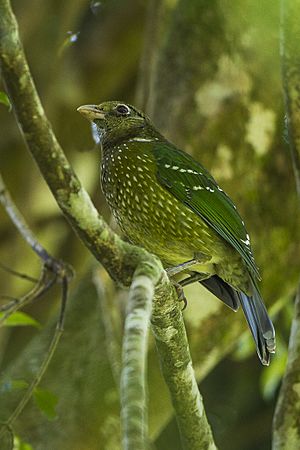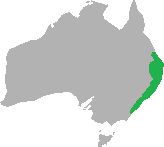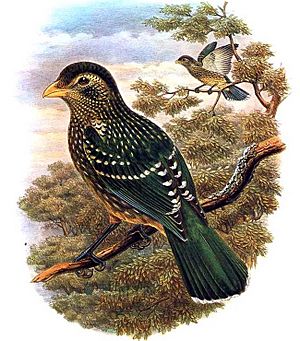Green catbird facts for kids
Quick facts for kids Green catbird |
|
|---|---|
 |
|
| Conservation status | |
| Scientific classification | |
| Genus: |
Ailuroedus
|
| Species: |
crassirostris
|
 |
|
| Geographic range. | |
The green catbird (Ailuroedus crassirostris) is a special type of bowerbird. You can find it in the warm, wet forests along Australia's east coast. Its home stretches from southeastern Queensland to southern New South Wales.
This bird gets its name from its unique call. It sounds a lot like a cat meowing! Some people have even mistaken its call for a crying child or a spooky vampire sound early in the morning. The green catbird looks quite similar to the spotted catbird, which lives much further north in Queensland.
Contents
Appearance and Features
Green catbirds are medium-sized birds. They are quite stocky, meaning they are strong and solid. They have long, powerful legs and a strong, thick beak.
Their backs, wings, and rump are a bright, shiny emerald green. They have clear white spots on their wingtips. These spots form two white stripes on their wings. Their tail is a brownish-green with white tips.
The bird's head is greenish-brown with black spots. It also has tiny pale buff flecks. Its chest is a greenish-buff color, sometimes dull emerald. It has distinct short white streaks.
The beak is a horn color, which is a yellowish-brown. Their legs are greyish-brown. The bird's eyes are a bright red when the sun shines directly on them. They also have a partial white ring around each eye.
It is very hard to tell male and female green catbirds apart. This is because they look almost exactly the same. Young birds also have similar colors, but their feathers are a bit duller. Very young birds have soft, fluffy grey feathers on their heads.
The Cat-like Call
The green catbird's call is very special. It can be a short, easy-to-recognize sound like "heer-I-aar." Or, it can be a long, drawn-out, shaky version that sounds like "heeeir-Ieee-aaa-aarr." This unique sound is why they are called "catbirds."
Where They Live and Their Home
Green catbirds live along the entire east coast of New South Wales. They are also found up to the Cooloola Coast in South East Queensland. They prefer to live in subtropical and temperate rainforests. Sometimes, you can find them in nearby eucalypt forests too.
A catbird's usual home area is about five acres. This area becomes much smaller during the breeding season. Their breeding spots often have several fig trees. These trees produce lots of ripe fruit for many months. This timing works perfectly with the catbird's breeding season. Green catbirds also drink and bathe in small pools of water. These pools can be found in tree cracks or along water paths.
Reproduction and Life Cycle
Male green catbirds are different from other male bowerbirds. They do not build a fancy bower (a structure to attract females). Instead, the male will clear a small area on the ground. He uses this spot to perform and show off to females. Like other bowerbirds, he tries to attract females. He does this by holding colorful fruits, flowers, and leaves in his beak.
Green catbirds are monogamous breeders. This means that once a female chooses a male, they stay together for life. The male helps keep this bond strong. He feeds the female throughout the year. They also sing calls together as a duet.
The breeding season usually runs from October to January. However, it can start as early as September or end as late as March. The nest is very large and bulky. It is made of big sticks held together with vine tendrils. The inside is lined with dry leaves. What's unusual is a wet, soft layer of decayed wood under the inner lining. This makes the nest extra large for the bird's size.
Nests are often placed in the thick tops of small trees. These trees have many twigs and stems to support the heavy nest. They might also choose thorny or stinging trees. Sometimes, they build nests in the top of a tree fern or in the cupped leaves of a bird's nest fern.
A female catbird usually lays 2 or 3 eggs. She sits on them for 23 to 24 days to keep them warm. The male helps raise the young birds. They stay in the nest for 20 to 22 days until they are ready to fly.
Scientists haven't studied how long green catbirds live in the wild very much. But it's thought they live about eight years. One catbird in a zoo lived for at least fifteen years!
Social Life
Green catbirds are usually seen alone or in pairs. After the breeding season, you might see them in groups of 3 to 5 birds. This happens when their young still need some help from their parents.
Green catbirds do not fly in large flocks. But outside of breeding seasons, it's common to see groups of about 20 birds. They all feed together in shared areas. This is most common during winter when fruits are plentiful. Other birds like satin bowerbirds, regent bowerbirds, and fig birds might join these feeding groups.
Green catbirds spend a lot of time looking for food. They search both inside and outside their own territory. They fiercely protect food sources within their territory from other males and females. Patrolling their territory is also a big part of their day. You will often hear them calling. This is most common during breeding season. They also call when predators are near their nests or when they are fighting with other birds over territory.
What They Eat
Green catbirds are omnivores. This means they eat both plants and animals. However, they mainly eat fruit. They enjoy figs and many other plant parts. This includes buds, shoots, flowers, and seeds. They will even visit fruit orchards if their natural food becomes hard to find.
They also eat insects like grasshoppers, cicadas, beetles, millipedes, and mites. Sometimes, they eat small animals like tree frogs and baby birds.
Green catbirds look for food in trees. They are active and careful. They move from branch to branch in the middle and upper parts of the trees while they search for food.
Protecting the Green Catbird
The green catbird is listed as "Least Concern" on the IUCN Red List of Threatened Species. This means it's not globally endangered right now. However, in New South Wales, where most of them live, they are listed as "Vulnerable."
Even though they are common in their favorite habitats, their future could be at risk. Forests and paperbark swamps are still being cleared for new buildings and developments. This loss of habitat is a threat to the green catbird.
See also
 In Spanish: Maullador verde para niños
In Spanish: Maullador verde para niños



